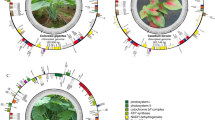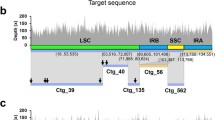Species in the genus Oryza (Poaceae) contain 10 genomic types and are distributed in pan-tropics of the world. To explore phylogenetic relationships of Oryza species having the AA-genome, DNA sequences of the chloroplast trnL intron and trnL-trnF spacer, mitochondrial nad1 intron 2, and nuclear internal transcribed spacer were analyzed, based on materials from 6 cultivated (O. sativa and O. glaberrima) and 13 wild accessions, in addition to a CC-genome species (O. officinalis) that was used as an outgroup. Analyses of the combined sequence data set from different sources provide a much better resolution of the AA-genome species than the individual data set, indicating the limitation of a single gene in phylogenetic reconstruction. The phylogeny based on the combined data set demonstrated an apparent grouping of the AA-genome Oryza species that was well associated with their geographic origin, although the Australian O. meridionalis showed its affinity with the African species. The geographic pattern of the phylogenetic relationship was probably attributed to the frequent genetic exchange and introgression among the AA-genome species from the same continents. In addition, Asian cultivated rice O. sativa showed its close relation to O. rufipogon and O. nivara, whereas African cultivated rice O. glaberrima was closely linked to O. barthii and O. longistaminata, indicating the independent domestication of the two cultivated species in different geographic locations.




Similar content being viewed by others
REFERENCES
Aggarwal, R. K., Brar, D. S., and Khush, G. S. (1997). Two new genomes in the Oryza complex identified on the basis of molecular divergence analysis using total genomic DNA hybridization. Mol. Genes Genet. 254:1–12.
Aggarwal, R. K., Brar, D. S., Nandi, S., Huang, N., and Khush, G. S. (1999). Phylogenetic relationships among Oryza species revealed by AFLP markers. Theor. Appl. Genet. 98:1320–1328.
Anderberg, A. A., Rydin, C., and Källersjö, M. (2002). Phylogenetic relationships in the order Ericales s.l.: Analyses of molecular data from five genes from the plastid and mitochondrial genomes. Am. J. Bot. 89:677–687.
Baldwin, B. G., Sanderson, M. J., Porter, J. M., Wojciechowski, M. F., Campbell, C. S., and Donoghue, M. J. (1995). The ITS region of nuclear ribosomal DNA: A valuable source of evidence on angiosperm phylogeny. Ann. Missouri Bot. Gard. 82:247–277.
Bao, Y., and Ge, S. (2004). Origin and phylogeny of Oryza species with CD genome based on multiple-gene sequence data. Plant Syst. Evol. 249:55–66.
Bautista, N. S., Solis, R., Kamijima, O., and Ishii, T. (2001). RAPD, RFLP and SSLP analyses of phylogenetic relationships between cultivated and wild species of rice. Genes Genet. Syst. 76:71–79.
Brar, D. S., and Khush, G. S. (1997). Alien introgression in rice. Plant Mol. Biol. 35:35–47.
Buso, G. S. C., Rangel, P. H., and Ferreira, M. E. (1998). Analysis of genetic variability of South American wild-rice populations (Oryza glumaepatula) with isozymes and RAPD markers. Mol. Ecol. 7:107–117.
Chang, T. T. (1976). The origin, evolution, cultivation, dissemination, and diversification of Asian and African rices. Euphytica 25:435–441.
Chang, T. T. (1985). Crop history and genetic conservation: Rice, a case study. Iowa State J. Res. 59:425–455.
Chang, T. T, Qu, S. H., Pathak, M. D., Ling, K. C., and Kauffman, H. E. (1975). The search for disease and insect resistance in rice germplasm. In Frankel, O. H., and Hawkes, J. G. (eds.), Crop Genetic Resources for Today and Tomorrow, Cambridge University Press, Cambridge, England, pp. 183–200.
Cheng, C. Y., Motohashi, R., and Ohtsubo, E. (2003). Polyphyletic origin of cultivated rice, based on the interspersion pattern of SINEs. Mol. Biol. Evol. 20:67–75.
Cheng, C. Y., Tsuchimoto, S., Ohtsubo, H., and Ohtsubo, E. (2002). Evolutionary relationships among rice species with AA genome based on SINE insertion analysis. Genes Genet. Syst. 77:323–334.
Chu, Y. E., Morishima, H., and Oka, H. I. (1969). Reproductive barriers distributed in cultivated rice species and their wild relatives. Jpn. J. Genet. 44:207–223.
Cordesse, F., Grellet, F., Reddy, A. S., and Delseny, M. (1992). Genome specificity of rDNA spacer fragments from Oryza sativa L. Theor. Appl. Genet. 83:864–870.
Cunningham, C. W. (1997). Can three incongruence tests predict when data should be combined? Mol. Biol. Evol. 14:733–740.
Doi, K., Nonomura, M. N., Yoshimura, A., Iwata, N., and Vaughan, D. A. (2000). RFLP relationships of A-genome species in the genus Oryza. J. Faculty Agric. Kyushu Univ. 45:83–98.
Doyle, J. J., and Doyle, J. L. (1987). A rapid DNA isolation procedure for small quantities of fresh leaf material. Phytochem. Bull. 19:11–15.
Farris, J. S., Kallersjo, M., Kluge, A. G., and Bult, C. (1995). Testing significance of incongruence. Cladistics 10:315–319.
Felsenstein, J. (1985). Condense limits on phylogenies: An approach using the bootstrap. Evolution 39:783–791.
Garris, A. J., Tai, T. H., Coburn, J., Kresovich, A., and McCouch, S. (2005). Genetic structure and diversity in Oryza sativa L. Genetics 169:1631–1638.
Ge, S., Sang, T., Lu, B. R., and Hong, D. Y. (1999). Phylogeny of rice genome with emphasis on origins of allotetraploid species. Proc. Natl. Acad. Sci. U. S. A. 96:14400–14405.
Ishii, T., Nakano, T., Maeda, H., and Kamijima, O. (1996). Phylogenetic relationships in A-genome species of rice as revealed by RAPD analysis. Genes Genet. Syst. 71:195–201.
Jena, K. K., and Khush, G. S. (1990). Introgression of genes from Oryza officinalis Well ex. Watt to cultivated rice, O. sativa L. Theor. Appl. Genet. 80:37–745.
Joshi, S. P., Gupta, V. S., Aggarwal, R. K., Ranjekar, P. K., and Brar, D. S. (2000). Genetic diversity and phylogenetic relationship as revealed by inter simple sequence repeat (ISSR) polymorphism in the genus Oryza. Theor. Appl. Genet. 100:1311–1320.
Khush, G. S. (1997). Origin, dispersal, cultivation, and variation of rice. Plant Mol. Biol. 35:25–34.
Kimura, M. (1980). A simple method for estimating evolutionary rate of base substitution through comparative studies of nucleotide sequences. J. Mol. Evol. 16:111–120.
Lu, B. R. (1998). Diversity of rice genetic resources and its utilization and conservation. Biodiversity Sci. 6:63–72.
Lu, B. R., Naredo, M. B. E., Juliano, A. B., and Jackson, M. T. (2000). Preliminary studies on taxonomy and biosystematics of the AA-genome Oryza species (Poaceae). In Jacobs, S. W. L., and Enerett, J. (eds.), Grasses: Systematics and Evolution, CSIRO, Melbourne, Australia, pp. 51–58.
Lu, B. R., Zheng, K. L., Qian, H. R., and Zhuang, J. Y. (2002). Genetic differentiation of wild relatives of rice assessed by RFLP analysis. Theor. Appl. Genet. 106:101–106.
Martin, C., Juliano, A., Newbury, H. J., Lu, B. R., Jackson, M. T., and Ford-Lloyd, B. V. (1997). The use of RAPD markers to facilitate the identification of Oryza species within a germplasm collection. Genet. Res. Crop Evol. 44:175–183.
Morishima, H., and Oka, H. I. (1960). The pattern of interspecofic variation in the genus Oryza: Its quantitative representation by statistical methods. Evolution 14:153–165.
Morishima, H., Sano, Y., and Oka, H. I. (1992). Evolutionary studies in cultivated rice and its wild relatives. Oxford Surv. Evol. Biol. 8:135–184.
Nayar, N. M. (1973). Origin and cytogenetics of rice. Adv. Genet. Incorp. Mol. Evol. Med. 17:153–292.
Nishikawa, T., Vaughan, D. A., and Kadowaki, K. (2005). Phylogenetic analysis of Oryza species, based on simple sequence repeats and their flanking nucleotide sequences from the mitochondrial and chloroplast genomes. Theor. Appl. Genet. 110:696–705.
Oka, H. I. (1988). Origin of Cultivated Rice, Japan Scientific Societies Press, Elsevier, Tokyo.
Oka, H. I., and Morishima, H. (1982). Phylogenetic differentiation of cultivated rice, 23: Potentiality of wild progenitors to evolve the indica and japonica types of rice cultivars. Euphytica 31:41– 50.
Petersen, G., and Seberg, O. (2002). Molecular evolution and phylogenetic application of DMC1. Mol. Phylogenet. Evol. 29:43–50.
Ren, F. G., Lu, B. R., Li, S. Q., Huang, J. Y., and Zhu, Y. G. (2003). A comparative study of genetic relationships among the AA-genome Oryza species using RAPD and SSR markers. Theor. Appl. Genet. 108:113–120.
Saitou, N., and Nei, M. (1987). The neighbor-joining method: A new method for reconstruction phylogenetic trees. Mol. Biol. Evol. 4:406–425.
Sang, T. (2002). Utility of low-copy nuclear gene sequences in plant phylogenetics. Crit. Rev. Biochem. Mol. Biol. 37:121–147.
Second, G. (1982). Origin of the genetic diversity of cultivated rice (Oryza spp.): Study of the polymorphism scored at 40 isozyme loci. Jpn. J. Genet. 57:25–57.
Sharma, S. D. (1983). Conservation of wild species of Oryza. In: Rice Germplasm Conservation Workshop, International Rice Research Institute and International Board for Plant Genetic Resources, pp. 21–25.
Sitch, L. A., Dalmacio, R. D., and Romero, G. O. (1989). Crossability of wild Oryza species and their potential use for improvement of cultivated rice. Rice Genet. News Lett. 6:58–60.
Soltis, D. E., and Soltis, P. S. (1998). Choosing an approach and an appropriate gene for phylogenetic analysis. In Soltis, D. E., Soltis, P. S., and Doyle, J. J. (eds.), Molecular Systematics Plants, II: DNA Sequencing, Kluwer, Dordrecht, Netherlands, pp. 1–42.
Soltis, D. E., and Soltis, P. S. (2000). Contributions of plant molecular systematics to studies of molecular evolution. Plant Mol. Biol. 42:45–75.
Sun, C. Q., Wang, X. K., Li, Z. C., Yoshimura, A., and Iwata, N. (2001). Comparison of the genetic diversity of common wild rice (Oryza rufipogon Griff.) and cultivated rice (O. sativa L.) using RFLP markers. Theor. Appl. Genet. 102:157–162.
Swofford, D. L. (1998). PAUP: Phylogenetic analysis using parsimony (and other methods), version 4.0. Sinauer Associates, Sunderland, MA.
Taberlet, P., Gielly, L., Pautou, G., and Bouvet, J. (1991). Universal primers for amplification of three noncoding regions of chloroplast DNA. Plant Mol. Biol. 17:1105–1109.
Thompson, J. D., Gibson, T. J., Plewniak, F., Jeanmougin, F., and Higgins, D. G. (1997). The Clustal-X Windows interface: Flexible strategies for multiple sequence alignment aided by quality analysis tools. Nucleic Acids Res. 25:4876–4882.
Vaughan, D. A. (1989). The Genus Oryza L.: Current Status of Taxonomy, IRRI, Manila, Philippines.
Vaughan, D. A. (1994). The Wild Relatives of Rice: A Genetic Resources Guide Book, International Rice Research Institute, Los Banos, Philippines.
Vaughan, D. A., Morishima, H., and Kadowaki, K. (2003). Diversity in the Oryza genus. Curr. Opin. Plant Biol. 6:139–146.
Vaughan, D. A., Kadowaki, K., Kaga, A., and Tomooka, N. (2005). On the phylogeny and biogeography of the genus Oryza. Breed. Sci. 55:113–122.
Wang, Z. Y., Second, G., and Tanksley, S. D. (1992). Polymorphism and phylogenetic relationships among species in the genus Oryza as determined by analysis of nuclear RFLPs. Theor. Appl. Genet. 83:565–581.
White, T. J., Bruns, T., Lee S., and Taylor, J. (1990). Amplification and direct sequencing of fungal ribosomal RNA genes for phylogenetics. In Innis, M. A., Gelfand, D. H., Sninsky, J. J., and White, T. J. (eds.), PCR Protocols: A Guide to Methods and Applications, Academic Press, San Diego, pp. 315–322.
Xia, X., and Xie, Z. (2001). DAMBE: Data analysis in molecular biology and evolution. J. Hered. 92:371–373.
Yamanaka, S., Nakamura, I., Nakai, H., and Sato, Y. I. (2003). Dual origin of the cultivated rice based on molecular markers of newly collected annual and perennial accessions of wild rice species, O. nivara and O. rufipogon. Genet. Res. Crop Evol. 50:529–538.
Zhang, Q. F., Saghai-Maroof, M. A., Lu, T. Y., and Shen, B. Z. (1992). Genetic diversity and differentiation of indica and japonica rice detected by RFLP analysis. Theor. Appl. Genet. 83:495–499.
Zhu, Q. H., and Ge, S. (2005). Phylogenetic relationships among A-genome species of the genus Oryza revealed by intron sequences of four nuclear genes. New Phytol. 167:249–265.
ACKNOWLEDGMENTS
We thank Dr. N. R. Sackville Hamilton of the International Rice Research Institute (Manila, Philippines) for providing plant material for this study. This research was supported by the National Natural Science Foundation of China (30270149) and Chinese Ministry of Science and Technology (2006CB100205).
Author information
Authors and Affiliations
Corresponding author
Rights and permissions
About this article
Cite this article
Duan, S., Lu, B., Li, Z. et al. Phylogenetic Analysis of AA-genome Oryza Species (Poaceae) Based on Chloroplast, Mitochondrial, and Nuclear DNA Sequences. Biochem Genet 45, 113–129 (2007). https://doi.org/10.1007/s10528-006-9062-x
Published:
Issue Date:
DOI: https://doi.org/10.1007/s10528-006-9062-x




